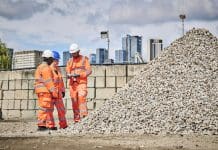As COP28 approaches, there are renewed calls for a clearer definition of net zero buildings and an internationally agreed certification/verification system
Despite UN goals for all buildings completed after 2030 to be net zero in operation, a new report from the World Business Council for Sustainable Development (WBCSD) and Arup has shown the challenges facing the built environment.
Net Zero Operational Buildings: State of the Art shows that there is not a single national policy requiring buildings to produce net zero emissions now or in the future, reducing hopes of adhering to the Paris 1.5ºC agreement.
With a new area the size of Paris in development around the globe every week and current buildings in operation accounting for over a quarter (28%) of global energy-related carbon emissions, drastic and urgent action is required to turn the tide on net zero buildings.
A stronger definition of net zero building will establish stronger framework and policy
The WBCSD and Arup have called for an internationally agreed definition for net zero buildings- including a greater distinction between buildings that are verifiably net zero in operation and buildings that are have the potential to be so.
It is hoped that clear and firm definitions of these terms will aid in stimulating more robust industry standards, national and local government policy.
“We need clarity in the sector”
Stephen Hill, sustainability and building performance expert at Arup, said: “We are on the cusp of a large-scale transition to net zero emissions in the property sector. But the target is not yet clearly in sight. We need clarity in the sector if we are to unlock the change that is desperately needed across the entire supply chain.”
Roland Hunziker, director for built environment at the WBCSD, said: “The buildings sector is critical to achieve the energy transition, as it consumes more than half of the world’s electricity. Reducing energy consumption and switching to renewable energy are two sides of the same coin to achieve net zero operational buildings at scale in line with available capacity.”
Suggested clear principles for net zero buildings in the report include:
- Have reduced its energy demand sufficiently to be consistent with the transition to 100% renewable energy for the market in which it operates
- Be capable of operating on 100% renewable energy sources (electricity/thermal), disengaging from fossil fuel use
- Purchase 100% renewable energy through a tariff or Power Purchase Agreement that is demonstrably additional to national renewable obligations
- In emerging markets where the above is not feasible, purchase carbon offsets to a recognised international standard would be an alternative means of achieving operational net-zero in the short term while transitioning toward net-zero.
The report also highlights projects with innovative solutions
The report also calls out examples around the world of buildings using innovative solutions to make sure they are truly net zero operationally, such as:
The Bullitt Center in Seattle, Washington, USA uses all electric reversible heat pumps, exchanging thermal energy between the building and 120 metres underground to radiantly heat the building in the winter and cool it in the summer.
The roof holds a large array of photovoltaic solar panels, producing 230 MWh of electricity per year, helping the building sell excess electricity to the grid in the summer.
The Ridge, in Cape Town, South Africa, provides heating and cooling through a combination of mechanical air conditioning equipment including heat pumps, passive cooling and natural ventilation.
These take advantage of the climate and optimise the amount of sunlight that penetrates the building through a ‘zigzag façade’.














